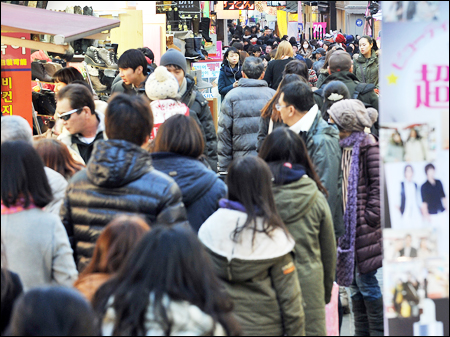Tourists flock to Myeong-dong

People flock to a street in Myeong-dong, which the Korea Chamber of Commerce and Industry says, is one of the most popular shopping areas, along with Dongdaemun, for Japanese and Chinese tourists.
Cosmetics most popular product among Chinese, Japanese
Seoul’s Myeong-dong shopping district is the most popular tourist attraction among Japanese travelers, while Dongdaemun (east gate), another giant shopping area in the capital, is the most sought-after location among Chinese visitors, a survey showed Thursday.
Inbound travelers from the two neighboring countries constituted more than half of 9.79 million visitors to Korea last year. The two spots were crowned in a recent survey of 200 visitors from the two countries by the Korea Chamber of Commerce and Industry (KCCI).
Myeong-dong is located in the heart of Seoul and is packed with fashion brand stores, jewelry shops, pubs and restaurants. Dongdaemun situated near Myeong-dong, is home to several giant shopping malls and outdoor markets.
Seven out of 10 Japanese tourists visited Myeong-dong for shopping, the survey showed, while the same number of Chinese travelers visited Dongdaemun for the same purpose. Other favorite tourist attractions of them were Namdaemun (south gate), Insa-dong and Itaewon, the survey said.
Chinese were found to show more interest in high-end products than their Japanese counterparts as they purchased mostly cosmetic goods, clothes, medical herbs and other high-priced items. In contrast, Japanese visitors tend to buy dried seaweed, traditional craftwork and other modestly-priced food items as souvenirs, the KCCI said.
The survey shows Chinese shoppers are price-conscious, citing statistics that 60.4 percent of surveyed Chinese travelers read price tags first. Nearly 62 percent of surveyed Japanese tourists paid attention to unique products that are on sale only in Korea.
Regarding luxury goods, 60.4 percent of Japanese travelers said they are available at relatively cheaper prices than their home country, while only 34.4 percent of Chinese people echoed the view.
They said the most urgent mission for Korea to establish a better environment for foreign shoppers is to develop products that could easily satisfy diverse tastes of inbound travelers. They also complained about a lack of facilities for entertainment and interpretation services.
Despite that, 68.5 percent of them said they will revisit Korea within the next three years.
Nearly 900,000 Japanese tourists visited Korea during the first three months of this year, followed by Chinese (520,000) and Americans (150,000).
The tourism authorities expect more visitors during the second quarter thanks largely to consecutive holidays in both Tokyo and Beijing, which start on April 28 and continue until early next month.
It said more than 130,000 Japanese nationals will visit Seoul during the Golden Week holidays, while around 20,000 Chinese travelers are expected during their Labor Day holidays.
Another survey by the KCCI said 32.2 percent of Chinese visitors spend over $1,000 per person shopping here, while only 4.2 percent of Japanese respondents said they did the same. About 81.5 percent of Japanese tourists said they spent less than $500 shopping, compared with 37.9 percent among the Chinese.
The KCCI said an increasing number of tourists from China and other Asian countries come here for shopping, stressing tourism authorities and retail businesses should make more efforts to improve related infrastructure. <Korea Times/ Park Si-soo>
























































